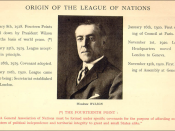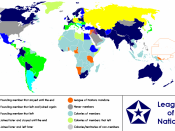"The League had no means of enforcing its decisions other than the effect of world opinion. If a power chose to be defiant, there was nothing effective that the League could do." S Reed Brett wrote this in the book, European History 1900-1960, in 1967. This quote exactly described the situation and the conditions of the League of Nations in the 1920s. They were successful in preventing minor conflicts between countries and improving the living conditions of citizens in the world, but whenever a country decided to be defiant or noncompliant, the League of Nations was useless because they were not capable of enforcing their decisions. The League of Nations had 4 main aims and they were to establish self-determination, disarm nations, stop wars, and improve the world. The League of Nations was approximately 50% successful in the 1920s because their aim of improving the world resulted in nearly 100% completion, their aim of disarmament resulted in 50% agreement, their aim of preventing wars resulted in 50% completion, and their aim of self-determination resulted in nearly 0% success, and the average of the success of the League of Nations would be 50%.
The League of Nations was 50% successful in the 1920s because their aim of improving the world was extremely successful and it nearly achieved 100% of their objectives. Although the International Labor Organization failed in winning the support the nations for a 48-hour workweek, the League of Nations oversaw numerous organizations that were successful in other areas. During the 1920s, the League freed over 200,000 slaves in Sierra Leone and formulated attacks to prevent the practice of forced labor in Africa. It even reduced the death rate of workers in Tanganyika from 55% to 4%. The Health Organization worked to prevent diseases such as malaria and leprosy from...


